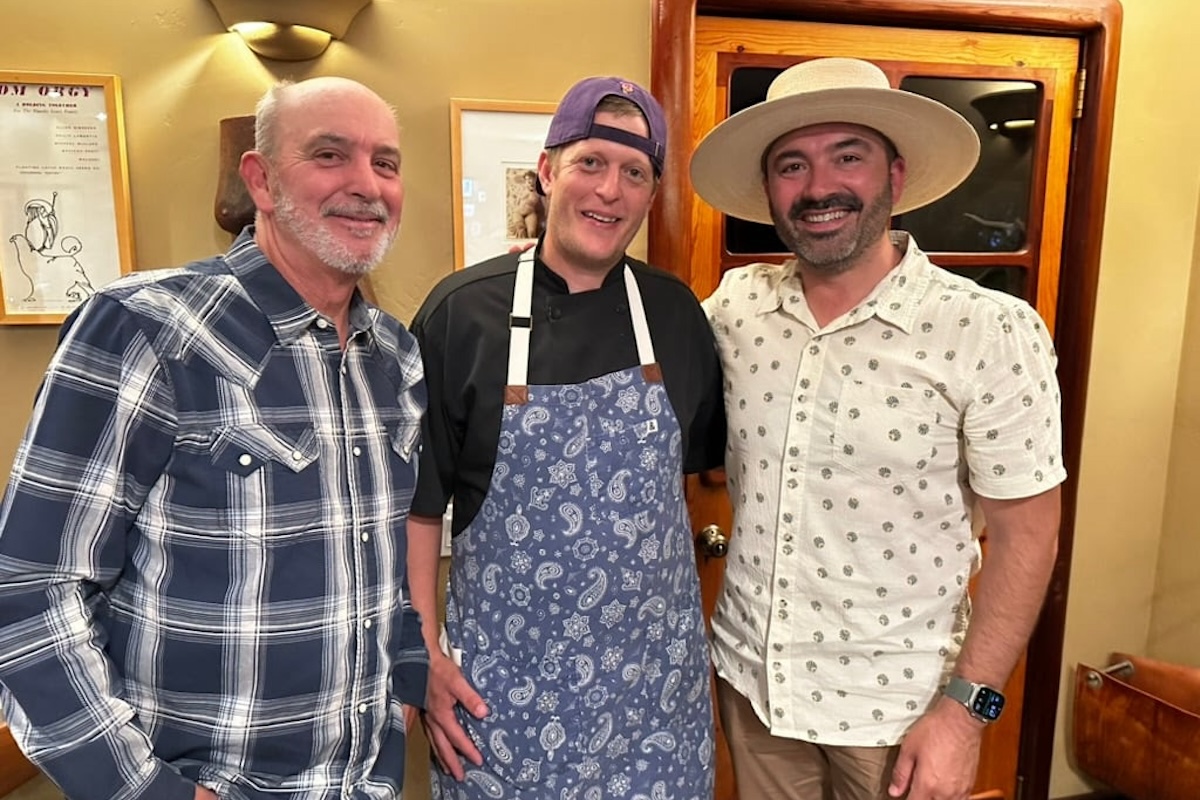Old Vines and New Wines in Paso Robles

Sign up to get Matt Kettmann’s Full Belly Files, which serves up multiple courses of food & drink coverage every Friday, going off-menu from our regularly published content to deliver tasty nuggets of restaurant, recipe, and refreshment wisdom to your inbox
Here’s the second part of my recent two-day jaunt to see six wineries from the Santa Maria Valley and S.L.O. Coast up into Paso Robles. If you missed last week’s introduction and my visits to Cambria, Outward, and Chronic Cellars, you can catch up by clicking here. Next up in this week’s Full Belly Files: Nenow Family Wines, Linne Calodo, and Lopai Cellars, with an overnight stay at Inn Paradiso.
NENOW FAMILY WINES: When Drew Nenow was just a 12-year-old 8th-grader growing up in San Diego County, he wrote a letter to his future self explaining that he wanted to study wine in college and become a winemaker. “It’s not quite what I thought it would be,” said Nenow with a laugh as he showed me the cellar for Nenow Family Wines, which he runs alongside his wife, sister, and brother-in-law with the support of their extended family.

He caught the bug so early because his aunt and uncle owned a winery in the Napa Valley (then Behrens & Hitchcock, now Behrens Family Winery), where his immediate family would spend a few weeks every year. That led his own dad, Robert Nenow, to start an eponymous Napa brand that lasted about a decade.
Drew followed that childhood dream to Cal Poly, during which time he worked for Turley Wine Cellars with Ehren Jordan and Tegan Passalacqua. Upon graduating in 2013, he worked for Villa San Juliette under Matt Ortman and then signed on with ONX in 2015, becoming head winemaker in 2018.
I’ve been reviewing ONX wines since before he started, and they’ve always impressed me for being extremely bold and savory yet balanced with proper acidity and texture. I didn’t “meet” Drew until a Rhône Rangers panel we did via Zoom last June, and this recent visit to his cellar in Tin City was the first time we actually met in person.
He shared a lineup going back to his inaugural vintage of 2017, explaining the stories behind each bottling’s name, like the numerology link for finding life balance represented by the Rhône blend “Elevens” and the nod to Drew being the youngest of five kids in “Last of 5,” a super-refreshing, chillable cinsault. His strategic sourcing from more than a dozen top-shelf Westside Paso vineyards is quite enviable, with sites such as Alta Colina, Gateway, Kiler Canyon, Hawks Hill, York Mountain, and Coakley adding depth to the bottlings.
Today, Nenow Family Wines hovers around the 1,500-case level, and they share a tasting room with Hawks Hill Ranch in a comfortable cottage off of Adelaida Road. That’s where Drew and I sipped on his pale rosé called Roesé (named after his sister and brother-in-law, last name Roesbery), his chalky white Rhône blend called The Tightrope, and that thrilling cinsault while enjoying Red Scooter Deli sandwiches on his patio. I’d recommend doing the same.
LINNE CALODO: Matt Trevisan left his hometown of Escondido in the early 1990s to attend Cal Poly, where the budding pilot studied aeronautical engineering before switching to biochemistry. He came to realize that both disciplines would most likely lead to a life sitting at a computer or in a lab being a tiny cog in massive corporate machines, with any tangible impacts taking years, perhaps even decades, to become reality, if they ever even did.
Meanwhile, his roommate Justin Smith’s dad Pebble Smith was in the wine business, sourcing grapes for Fetzer, and planting his own vineyard in Paso Robles, where Trevisan got to try his hand at grapes. “The idea of taking a piece of land, planting it yourself, and creating your own farming philosophies?” Trevisan pondered rhetorically, as we rolled around the Willow Creek District in his new Rivian pickup.

His answer for his was driving forklifts for Justin and Wild Horse wineries during their mid-1990s expansions, and then launching Linne Calodo with Justin Smith in 1998. (Smith left four years later to start Saxum.) Linne Calodo quickly became a darling of the emerging Paso Robles wine scene of the early 2000s, when the region’s mountainous westside vineyards and their ability to grow bold Rhône wine grapes became national news.
“We wanted to make change,” he said of the early days. “We wanted to make wines from our neighborhood, blends that were not beholden to varietals.”
In 2005, Trevisan planted his Linne Calodo estate vineyard, located right near the intersection of Highway 46 and Vineyard Drive, and added the Stonethrower Vineyard just down the road in 2012. “Everything I’ve planted myself,” said Trevisan.
He’s proudly anti-bandwagon when it comes to viticultural trends, but his techniques favor dry farming and no-till when possible, much like the regenerative movement. He’s pro-organic, railing against nearby properties that seem to nuke the earth with various ’cides, but also flexible with making decisions based on what vines need. “Organic and biodynamic doesn’t account for water usage at all, and they don’t account for energy usage,” said Trevisan, who keeps all of that in mind for his properties.
Of the 5,000 cases he makes under Linne Calodo and the 2,000 he does under his more affordable label Slacker, most are Rhône blends, including the whites. But there’s a touch of cabernet sauvignon and tempranillo in the mix, and then a healthy chunk of zinfandel as well.
Since Linne Calodo’s start a quarter-century ago, much of that zinfandel has long come from the Cherry Vineyard, a 2.5-acre plot planted in 1977. Those head-trained, dry-farmed vines only squeeze out about a half-ton of fruit per acre, to which the roughly 200 chenin blanc bushes sprinkled around the vineyard add “aromatic mágico” when co-fermented with the zin.
In February, Trevisan was able to buy the 170-acre property from the Cherry family, which features another 80 or so acres of plantable slopes. “I haven’t been out here much,” Trevisan told me as we rambled his Rivian over grasslands and oak-shaded, occasionally invisible trails along Willow Creek on the backside of his new ranch, which abuts the respected G2 Vineyard.
It’s a pretty stunning property, close to his estate, but Trevisan isn’t quite sure what to do yet, as the purchase was a very quick surprise acquisition for him. “Today, I plant vineyards with the idea of a spice rack,” said Trevisan, who doesn’t want to add anything to his wines to make them complete. “I want to have all the components that allow you to freely make a wine.” And now he’s got a much larger potential rack to develop.
See linnecalodo.com.
LOPAI CELLARS: Though just now releasing their first wines, the father-son duo behind Lopai Cellars is well positioned to make a major impact on the Paso Robles wine scene.
They’ve got hands-on cellar experience thanks to dad Paul “P-Lo” Lopez, a Morro Bay native who retired after 32 years in the grocery business and then worked for 14 vintages at Villa Creek, Alta Colina, and Denner Vineyards. And they’ve got innovation and funding covered by the son, Brian Lopez, who was the seventh employee for the software company GitHub when it was acquired by Microsoft for $7.5 billion in 2018.



When we met at their Willow Creek District estate just four minutes from Linne Calodo, which they purchased in 2019, Brian told me about an hour-long conversation he had with ChatGPT. “It figured out that we can cut our water use in half,” he said, explaining that the AI program analyzed a ton of monitoring data to determine as much.
Elevating technology to save water while moving toward electric energy, rather than gas and diesel, are just the initial steps of Lopai’s mission to respect the land, where the Lopez family first settled atop the Cuesta Grade back 1870. They’re also focused on bringing their estate — where 32 acres are planted, with the potential to grow up to 55 — into a healthier state, as the previous owners had been pushing the vines for quantity over quality.

“I’m just trying to bring new life back,” said Paul, who recently enlisted Bill Gibbs as a farming consultant. For winemaking, they’re working with Anthony Yount, whom Paul worked with for years at Denner. Yount and Brian also just acquired the historic Windward Vineyard, known since 1989 as Paso’s sole hotspot for pinot noir. (That pinot probably will be yanked soon, though.)
After our quick vineyard tour, we gathered for a wine-paired dinner at Inn Paradiso, the bizarrely brilliant property that I first visited and wrote about in this Full Belly Files from last winter. On hand was the inn’s owner Steve Werndorf as well as Yount; his wife, Hillary; Paul’s wife, Michelle Rollins; and Brian’s wife, the singer Nicole Stromsoe. Preparing the food was Chef Justin Lewis, who’s worked kitchens from the Malibu Inn to Firestone Walker Brewing, most recently serving as culinary director for the Nomada Hotel Group (S.L.O.’s Granada Hotel, Skyview Los Alamos, etc.).

The six-course spread was a masterclass in distinctive yet comfortably familiar flavors, proper portions, and pairings that actually worked across the board, from the Luxembourg bubbles that went with the Grassy Bar oysters to the five Lopai selections: Happy Canyon semillion with bass crudo; the cool-climate-y La Montanita syrah from atop Highway 46’s peaks with roasted beet salad; the Jada Vineyard syrah with unctuous duck confit sugo, San Miguel–made sheep’s cheese by Black Market, and Mighty Cap mushrooms; the estate cabernet sauvignon with smoked pork belly; and the Denner Vineyard –grown Heliotrope blend of mourvèdre and cab with the cherry-chocolate tart dessert.
Because that last wine was served alongside a Spanish mourvèdre-cab blend from Jumilla called Clio that inspired Lopai’s Heliotrope, it made for a memorable experience.
I was surprised to learn that a pairing of grapes well-known across the Central Coast like mourvèdre and cab could work so well together, with mourvèdre filling in the earthy gaps of the herb- and fruit-driven cab. That Brian and Paul Lopez were confident enough in their early efforts to share the Heliotrope alongside its Clio inspiration was a testament to how seriously they’re taking their father-son adventure.
When everyone left, Werndorf and I sipped on a bit of Cuish mezcal to finish the night, then met up again for coffee and fresh-picked berries the next morning. I peeked at the pool as the hot Paso sun rose, but had to hustle back home. Next time.
See lopaicellars.com and innparadiso.com.

From Our Table
Here are some recent stories you may have missed:
- Rebecca Horrigan reports on The Oyster Bar, a new shellfish spot within Moby Dick restaurant on Stearns Wharf.
- There’s still some space left in Saturday’s tamale-making class led by Richard Lambert, the founder of National Tamale Day. Check out details here.
- Tia Trinh reports on Rori’s Artisanal Creamery and its plans for National Ice Cream Day on July 21.
- Leslie Dinaberg didn’t realize the Filipino-inspired dinner she was attending at Mattei’s Tavern was also a goodbye party for chef Rhoda Magbitang.
- Coming in hot from last night’s STARS of Pinot Noir event in Hollywood, I’ll be at the Cuyama Buckhorn tonight to meet Vahe Keushgerian and try his Armenian wines in person.
- I interviewed tattoo legend and urban art superstar Mr. Cartoon about his recent collaboration with Title X Wines to craft a magnum-sized bottle of Happy Canyon red wine.
- Wearing my Wine Enthusiast hat, I wrote about the top tasting rooms to visit right now in the Temecula Valley, based on the advice of hospitality experts who live there.
- Also for WE, I wrote about double- and hyper-decanting wine, with comments from Tristan Pitre of San Ysidro Ranch and my high school buddy Greg Jones, who was the first to show me that a blender can enhance a tightly wound wine. (He was also the first person I ever really interviewed at all, prior to our friendship, when he was the captain of the JV football team and I was writing an article for our school newspaper.)
Premier Events
Sat, Sep 07
7:00 PM
Santa Barbara
Voracious Records Presents JOVETH single release p
Sat, Sep 07
4:30 PM
Santa Barbara
Classical Music of India, Math Behind the Sound
Sat, Sep 07
6:00 PM
Santa Barbara
4xSB Presents: The Idiomatiques & Nightbirds
Wed, Sep 11
5:30 PM
Santa Barbara
Sewing and Mending Club
Wed, Oct 02
12:00 PM
Santa Barbara
“Project Fiesta!” Celebrates 100 Years of Fiesta
Wed, Oct 09
5:30 PM
Santa Barbara
Sewing and Mending Club
Sat, Oct 12
8:00 PM
Santa Barbara
Star Party at the SBMNH
Sat, Sep 07 7:00 PM
Santa Barbara
Voracious Records Presents JOVETH single release p
Sat, Sep 07 4:30 PM
Santa Barbara
Classical Music of India, Math Behind the Sound
Sat, Sep 07 6:00 PM
Santa Barbara
4xSB Presents: The Idiomatiques & Nightbirds
Wed, Sep 11 5:30 PM
Santa Barbara
Sewing and Mending Club
Wed, Oct 02 12:00 PM
Santa Barbara
“Project Fiesta!” Celebrates 100 Years of Fiesta
Wed, Oct 09 5:30 PM
Santa Barbara
Sewing and Mending Club
Sat, Oct 12 8:00 PM
Santa Barbara




















You must be logged in to post a comment.